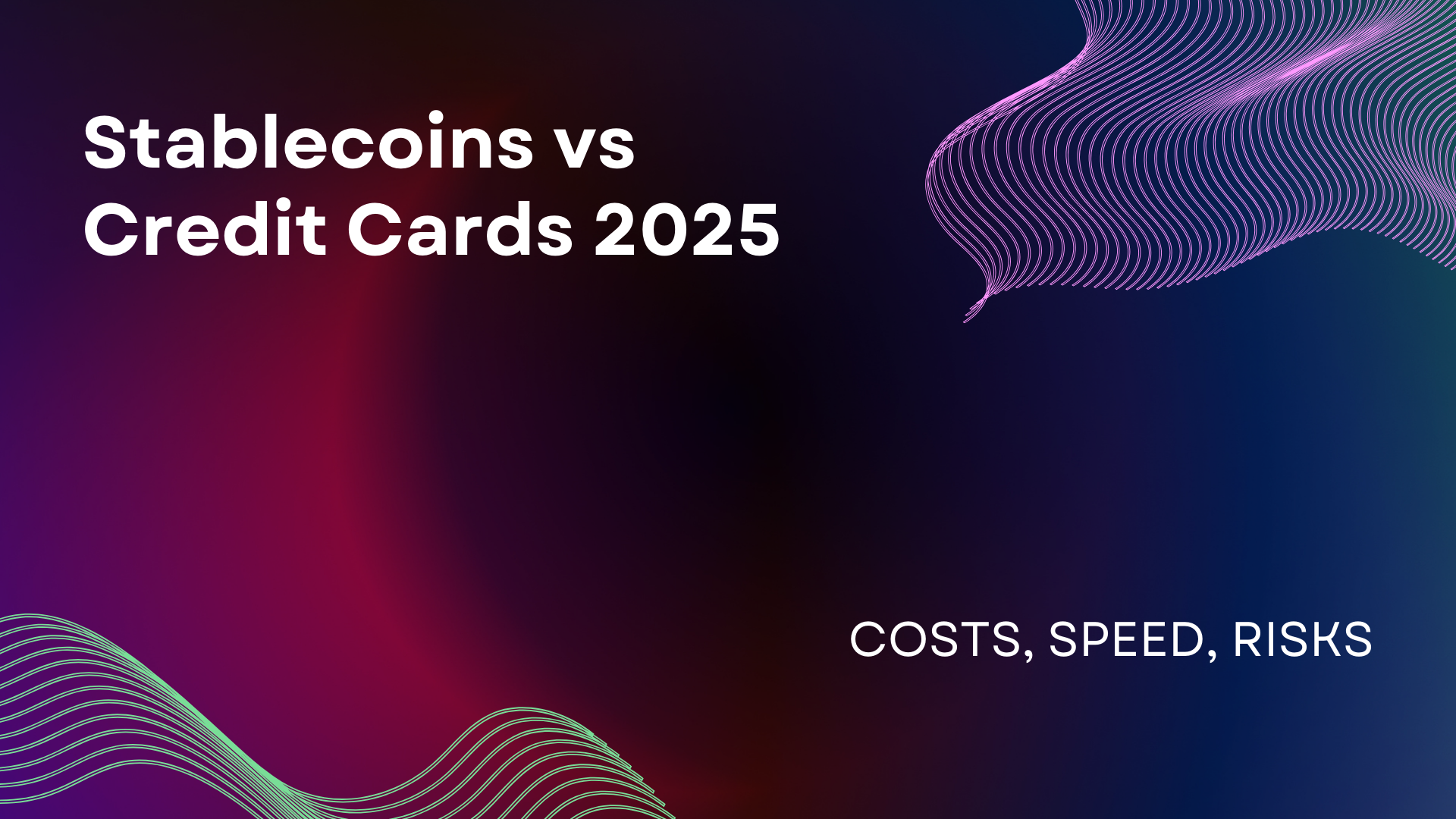
Credit cards dominate retail payments, but stablecoins are quietly attacking the profit pool—especially cross-border and high-fee categories. Cointelegraph frames it as a coming $100B U.S. payments battle, asking whether stablecoins can disrupt Visa and Mastercard’s economics. We dig into the data from central banks, regulators, and major networks to separate signal from hype.
The fee gap: where the wedge opens
- Card economics. In the U.S., the merchant discount rate commonly lands around ~2–3% (varies by industry and card tier). Visa’s own materials emphasize that published interchange is only part of that total; processors and assessments add more. Recent industry snapshots peg typical online rates near ~2.1–2.6% before extras.
- Regulatory anchors. For debit, the Fed’s Regulation II caps covered issuers at $0.21 + 0.05% (+$0.01 fraud adjust.), underscoring how policy can compress fees—though this doesn’t apply to credit.
- Stablecoin processors. Coinbase Commerce discloses a 1% processing fee; Stripe case studies show ~1.5% on stablecoin payments versus ~4.5% on some international cards—illustrating why cross-border merchants are experimenting.
Investor takeaway: Stablecoins don’t “zero out” costs, but in cross-border and long-tail markets they can undercut card rails by 50–70% on processing—prime territory for disruption.
Settlement & cash-flow: instant vs. T+1–3
- Cards: Even with modern acquirers, merchant funding typically arrives in 1–3 business days, and dispute risk lingers for months.
- Stablecoins: On-chain transfers settle 24/7 with near-instant finality at the network layer. Even incumbents are leaning in: Visa expanded USDC settlement beyond pilots, highlighting 365-day availability and broader chain support.
Investor takeaway: Faster cash conversion cycles matter for working-capital-intensive merchants; stablecoin rails convert an invisible “time tax” into a selling point.
Chargebacks & consumer protection: the trade-off
- Cards come with chargeback rights, often up to ~120 days (sometimes longer for specific scenarios). This protects buyers but creates residual risk and back-office cost for merchants.
- Stablecoins are typically push payments with no default chargeback when self-custodied. Processors can layer policy-based refunds and dispute tooling, but it’s not the same as network-mandated chargebacks.
Investor takeaway: Where fraud/returns are high, cards remain sticky. Where buyers are businesses or trust is established, “no-chargeback” push rails are attractive.
Adoption: from experiments to real processing
- Networks & processors: Visa widened stablecoin settlement in 2023–2025; Stripe rolled out USDC acceptance and, with Shopify, lets merchants receive stablecoins or auto-convert to fiat. Coinbase launched Payments to abstract stablecoin complexity for commerce platforms.
- Volumes: The IMF estimates USDT+USDC trading volume hit ~$23T in 2024 (huge, but heavily exchange flows). Independent datasets suggest multi-trillion on-chain stablecoin transactions as well, with 2025 tracking higher. The direction is clear: scale is real, though “commerce” is still a small slice.
Investor takeaway: Stablecoins are past proof-of-concept. The question is mix shift—how much of that volume becomes retail/commercial payments versus trading collateral.
Regulation: clarity fuels adoption, caution tempers it
- EU: MiCA stablecoin rules for e-money tokens (EMTs) and asset-referenced tokens (ARTs) took effect June 30, 2024; CASP rules followed in 2025. Expect stringent reserve, disclosure, and redemption standards.
- BIS view: The BIS warns stablecoins “perform poorly” as money and need tight oversight; policymakers worry about singleness/integrity and spillovers. This shapes how far regulators let private tokens displace bank money.
Investor takeaway: In Europe, compliant EMT‐style stablecoins may gain institutional trust; globally, BIS-driven scrutiny keeps a lid on unfettered growth.
Competitive positioning: where each wins
Cards win when…
- You need ubiquitous acceptance, rewards, and strong consumer protections (chargebacks).
- The buyer experience must be frictionless for mainstream users.
Stablecoins win when…
- Cross-border payments dominate, or card fees are punitive (travel, freight, B2B marketplaces).
- Merchants prize 24/7 settlement and lower processing costs more than chargebacks.
- Platforms can abstract wallets/keys (Stripe/Coinbase), making crypto invisible to the end user.
Key risks investors should model
- Regulatory tightening. Central-bank bodies (BIS) remain skeptical; EU MiCA is strict; future rules (redemptions, reserves, disclosures) could raise issuer costs.
- Operational/peg risk. Reserve transparency, chain outages, and bridges present non-trivial tail risks.
- Illicit-finance optics. High-profile cases keep pressure on issuers and exchanges. (BIS and other watchers flag integrity concerns.)
- Incumbent response. Card networks are lowering fee pressure via settlements and innovating on their own tokenized money rails. Lower swipe fees blunt the stablecoin pitch.
Portfolio angles: how to play it
- Payment networks (Visa/Mastercard): Don’t write them off. They’re integrating stablecoins for back-end settlement, preserving moats in identity, risk, and acceptance. Watch for stablecoin volume routed through network partners—a sign incumbents are co-opting the threat.
- Stablecoin infrastructure (issuers/processors): USDC/PYUSD partnerships with platforms (Coinbase waiving fees on selected stablecoins; Stripe cases at 1.5%) show early unit-economics wins in cross-border. Scale and compliance are the moat.
- Commerce platforms & enablers: Shopify+Stripe USDC support and Coinbase Payments let SaaS platforms monetize payment flow. Look for attach rates and take-rate stability as leading indicators.
- Public blockchains: Throughput/fees matter. L2s and high-TPS L1s that win stablecoin settlement can see durable demand beyond speculation.
What to watch next
- Fee cards vs. stablecoins: Track disclosed merchant rates for stablecoin acceptance (e.g., 1–1.5%) versus evolving card fees post-settlement caps.
- Settlement SLAs: More 365-day settlement proofs from networks/processors are a tell that “on-chain back-end, fiat front-end” is becoming normal.
- Regulatory milestones: EU implementation updates under MiCA; BIS/ECB commentary; national bills that set redemption and reserve rules.
- Mix shift in volumes: IMF and analytics houses on how much stablecoin flow is real commerce vs. trading collateral; rising merchant case studies beyond crypto-native verticals.
Conclusion
For now, credit cards still rule day-to-day commerce thanks to ubiquity and buyer protections. But stablecoins are carving a profitable niche—especially cross-border and high-fee segments—by offering lower processing costs (≈1–1.5%) and 24/7 settlement, increasingly delivered by the same companies merchants already trust. As regulation matures (EU MiCA), and as networks like Visa integrate stablecoin settlement, the real question isn’t “cards or stablecoins?”—it’s which rails run under the hood while merchants and consumers keep the same simple checkout. That’s where the investment upside—and defensibility—will show up.